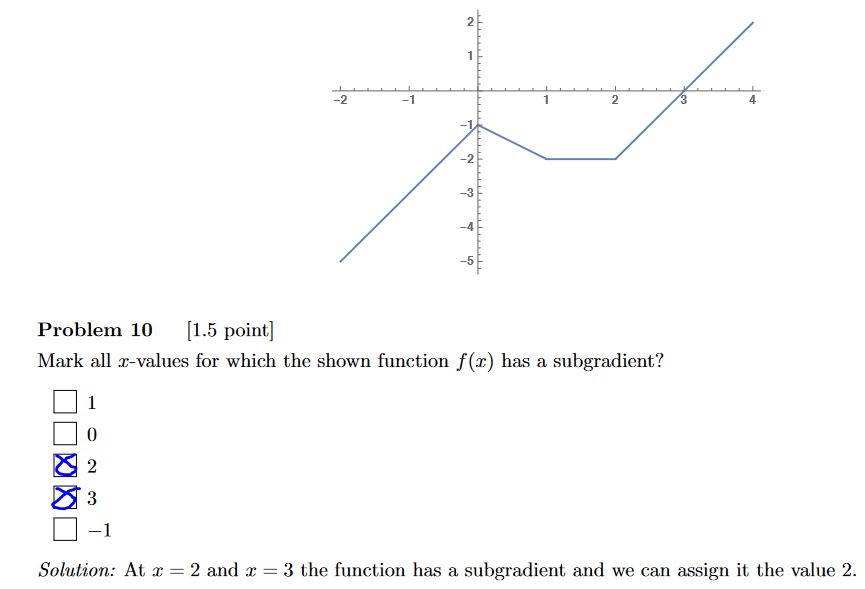Hello,
in the exam 2018 i don't get why the subgradient exists only at x=2 and x=3, because we saw in class that the subgradient exists where the fct can always lie above its linearization. Then why, there is no subgradient at x=-1, neither x=1?
What does assigning the subgradient to 2 mean? I solve these questions by trying to draw a line that will always be below the function. Is there another approach?
Hello,
I'm sorry to come back on this but I really do not understand why the subgradients are only at 2 and 3 and what that mean to assign the value 2 to the subgradient?!
Try to find a straight line that touches the function graph at the x=2 AND always lies below the function. It's impossible. Same for x=3. Hence, no subgradients exist. What is meant by the value of the gradient is the slope of the tangent that represents the subgradient.
Recommend: https://www.youtube.com/watch?v=urbBxgc7_DE&t=265s
Okay, thank you!
But I think just a small mistake, it's only possible for x=2 and x=3 but impossible for the other values of x proposed (you just said the contrary but I think it was a mistake, because the answer is precisely x=2 and x=3!)
The only possible value are x=2 and x=3. I think that the value of the subgradient is the slope of the line. If you look at the y-axis, you can see that the function goes from -2 to 0 while the value on the x-axis go from 2 to 3, hence the slope is 2. Furthermore, the only possible line that is always below the function at point x=3 is the line with slope 2 that goes through (3,0). It is the same thing for the point x=2. Hope it helps !
I am sorry to add one more question here, why can't \(x=-1\) have its subgradient? Like the line with slope 2 goes through(-1, -3), which is parallel with the line for point \(x=2\) and \(x=3\)?
@Anonymous said:
I am sorry to add one more question here, why can't \(x=-1\) have its subgradient? Like the line with slope 2 goes through(-1, -3), which is parallel with the line for point \(x=2\) and \(x=3\)?
Because for x>0 your line will be above the function !
subgradient exam 2018
Hello,
in the exam 2018 i don't get why the subgradient exists only at x=2 and x=3, because we saw in class that the subgradient exists where the fct can always lie above its linearization. Then why, there is no subgradient at x=-1, neither x=1?
At a singularity I think that is the most straightforward aproach.
1
it needs to stay below the linearization, not below and it needs to do so globally which it does not for -1 and 1
2
What does assigning the subgradient to 2 mean? I solve these questions by trying to draw a line that will always be below the function. Is there another approach?
At a singularity I think that is the most straightforward aproach.
1
Hello,
I'm sorry to come back on this but I really do not understand why the subgradients are only at 2 and 3 and what that mean to assign the value 2 to the subgradient?!
Try to find a straight line that touches the function graph at the x=2 AND always lies below the function. It's impossible. Same for x=3. Hence, no subgradients exist. What is meant by the value of the gradient is the slope of the tangent that represents the subgradient.
Recommend: https://www.youtube.com/watch?v=urbBxgc7_DE&t=265s
2
Okay, thank you!
But I think just a small mistake, it's only possible for x=2 and x=3 but impossible for the other values of x proposed (you just said the contrary but I think it was a mistake, because the answer is precisely x=2 and x=3!)
The only possible value are x=2 and x=3. I think that the value of the subgradient is the slope of the line. If you look at the y-axis, you can see that the function goes from -2 to 0 while the value on the x-axis go from 2 to 3, hence the slope is 2. Furthermore, the only possible line that is always below the function at point x=3 is the line with slope 2 that goes through (3,0). It is the same thing for the point x=2. Hope it helps !
Jup, sorry. I meant 'it is only possible in the case of x=2 and x=3, not the other ones'
1
I am sorry to add one more question here, why can't \(x=-1\) have its subgradient? Like the line with slope 2 goes through(-1, -3), which is parallel with the line for point \(x=2\) and \(x=3\)?
Because for x>0 your line will be above the function !
Add comment